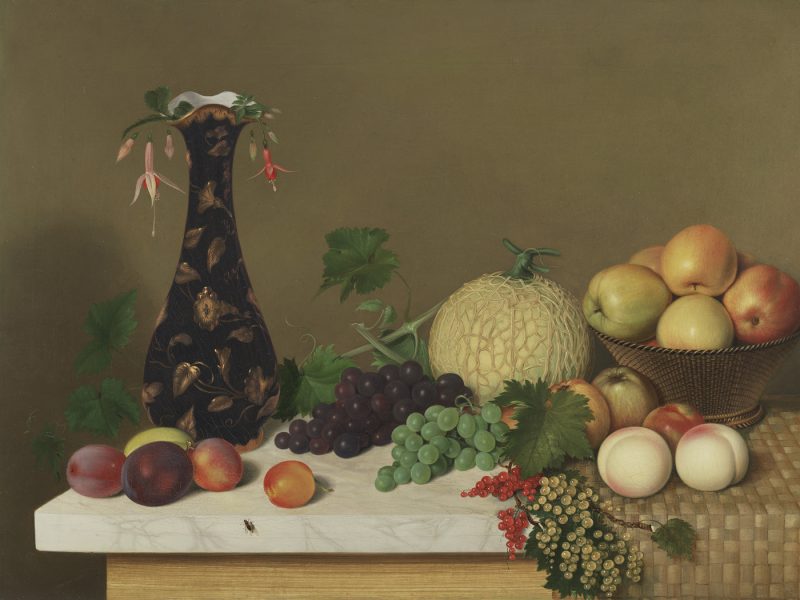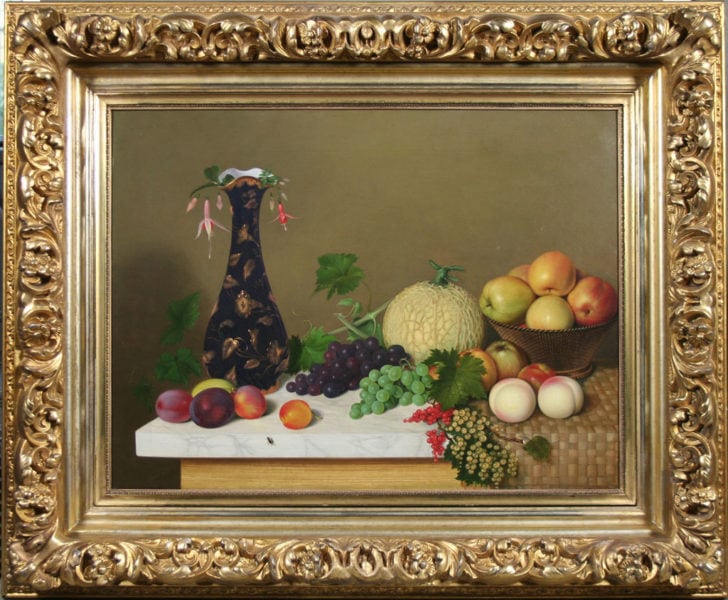Still Life with Fruit and Vase on a Tabletop, 1848
by J. Watson (b. 19th century)18 x 24 inches
signed and dated 1848 lower left
Provenance
Estate of Caroline Ryan Foulke, Palm Beach
J. Watson’s Still Life with Fruit and Vase on a Tabletop is a virtuoso depiction of forms, textures, and colors. Active in the mid-nineteenth century, Watson was associated with the Philadelphia school of still-life painters, adopting the style of such celebrated artists as Raphaelle and Rubens Peale.[1] While Still Life with Fruit trumpets the artist’s skill, it is also a meditation on the processes of making and viewing a painting.
The ostensible simplicity of the composition belies its careful construction. The earth’s bounty is tantalizingly arranged across a marble tabletop. Textures are lovingly depicted: gleaming porcelain, velvety peaches, translucent currants, reticulated cantaloupe skin, and serrated grape leaves invite the viewer to grasp at the canvas. While these contrasting elements provide an array of visual experiences, they are harmoniously balanced through light, color, and form. The objects are displayed at their best, each surface evenly illuminated and flaunting jewel-like tones. The rounded forms of the fruits echo the curvilinear vase and its drooping sprigs of fuchsia. The vertical thrust of the vase helps to enliven the overall horizontal arrangement.
In the tradition of Italian and Dutch still-life painting, Watson alludes to the ephemeral nature of his subject. The fruits are shown at perfection, but their different stages of maturity are a subtle reminder of the decay that must follow. The viewer is aware that the serene vision Watson has captured cannot last. The fly on the edge of the table acts as a further reminder of transience. This fleeting moment has been captured in paint, but its stillness emphasizes the evanescence of the myriad visual impressions of everyday experience.
Watson, like many American still-life painters, drew on the techniques of the Baroque masters. Like Caravaggio, he asserted the viewer’s role as a participant in the work of art. The muted wall in the background simultaneously highlights the volume of the objects and flattens foreground and background. This shallow arrangement seems to unite the viewer’s space with that of the picture.[2] The branch of currants is barely contained within the frame, spilling over the tabletop toward us. The trompe l’œil fly further confounds our physical distance from the painting. This illusionism and reference to the viewer highlight the nature of painting as construction—a visual record and a reflection of our experience of reality.[3] During the nineteenth century artists such as Watson defiantly pursued still life despite its lower status, pushing the limits of what the genre could communicate. Watson inherited Raphaelle Peale’s spare, essential style, qualities that pervaded American still-life painting after the Pennsylvania Academy’s influential exhibition of the Spanish Baroque artist Juan Sánchez Cotán’s work in 1818.[4] Like Cotán, Watson adopted an intense realism and crisp brushwork that brought lyricism and self-awareness to the genre.
Watson’s canvas also heralded the future possibilities of American painting.[5] He represented a variety of high and low, everyday and precious objects as well as several distinctly native varieties of plant. Fuchsia, a New World plant identified by the explorer and naturalist Charles Plumier in the late seventeenth century, became highly prized by plant collectors worldwide.[6] Like Charles Cromwell Ingham’s Flower Girl of 1846 (Metropolitan Museum of Art, New York), one of the earliest portrayals of an American street vendor, Still Life with Fruitsprominently displays a flowering fuchsia.[7] This addition firmly places Watson’s masterwork as a distinctly American production. The picture reveals Watson’s desire not only to record nature firsthand but also to elevate the aesthetic esteem of American art.[8]
IMH
Significantly, Still Life with Fruits previously formed part of the prestigious collection of Caroline Ryan Foulke, granddaughter of the trolley-car system tycoon Thomas Fortune Ryan.
[1]. On the Peale family and the development of still-life painting, see William H. Gerdts and Russell Burke, American Still-Life Painting (New York, Washington, and London: Praeger Publishers, 1971), p. 11.
[2]. Watson utilized many of the techniques pioneered by the Italian painter Michelangelo Merisi da Caravaggio (1571–1610). Caravaggio’s striking illusionism and use of bright, neutral backgrounds revolutionized still-life painting, elevating its ranking within the strict hierarchy of genres. Drawing from Lombard traditions, Caravaggio put still-life elements on equal footing with figures in works such as Boy with a Basket of Fruit(ca. 1593–4; Galleria Borghese, Rome) and Bacchus (ca. 1597; Uffizi, Florence); see Catherine Puglisi, Caravaggio (New York: Phaidon Press, 1998), pp. 37–61.
[3]. Still-life paintings have often been at the forefront of artistic explorations into the role of optical perception in recording the world. For an overview, see Peter Weiemair, ed., The Nature of Still Life: From Manet to the Present Day (Milan and Bologna: Galleria d’Arte Moderna and Bologna and Electa, 2001), pp. 16–25. On illusionism and American still-life painting, see David C. Ward and Sidney Hart, “Subversion and Illusion in the Life and Art of Raphaelle Peale,” American Art 8, no. 3–4 (Summer–Autumn 1994): 97–121.
[5]. On American nationalism and the role of still-life painting, see William H. Gerdts, Painters of the Humble Truth: Masterpieces of American Still-Life, 1801–1939 (Columbia and London: Philbrook Art Center and Columbia University Press, 1981), pp. 47–53.
[6]. Charles Plumier (1646–1704) identified the fuchsia plant, naming the species for the celebrated naturalist Leonhart Fuchs (1501–1566), in Nova plantorum americanarum fenera (Paris: Joannem Boudot, 1703).
[7]. In Flower Girl the vendor holds a potted fuchsia plant toward the viewer. The fuchsia was a native but still rare and coveted plant in America during the mid-nineteenth century; see Carrie Rebora Barratt, “Faces of a Nation: American Portraits of the 18th and Early 19th Centuries,” The Metropolitan Museum of Art Bulletin 61, no. 1 (Summer 2003): 5–56.
Artist Biography
J. Watson worked in the mid-nineteenth century among the Philadelphia school of still-life painters. Stylistically, his work is united with that of Philadelphia’s Peale family of artists, whose detailed still-lifes feature dramatic contrasts of light and dark tones. Watson endowed his paintings with a stunning realism, distinctly articulating the surface, volume, and form of each object. His precision, exquisite coloration, and decorative compositions formed alluring still-lifes that appealed to patrons and critics alike. In recent years, Watson’s paintings have been sold as printed reproductions and have appeared in the collection of the Schwarz Gallery in Philadelphia.



